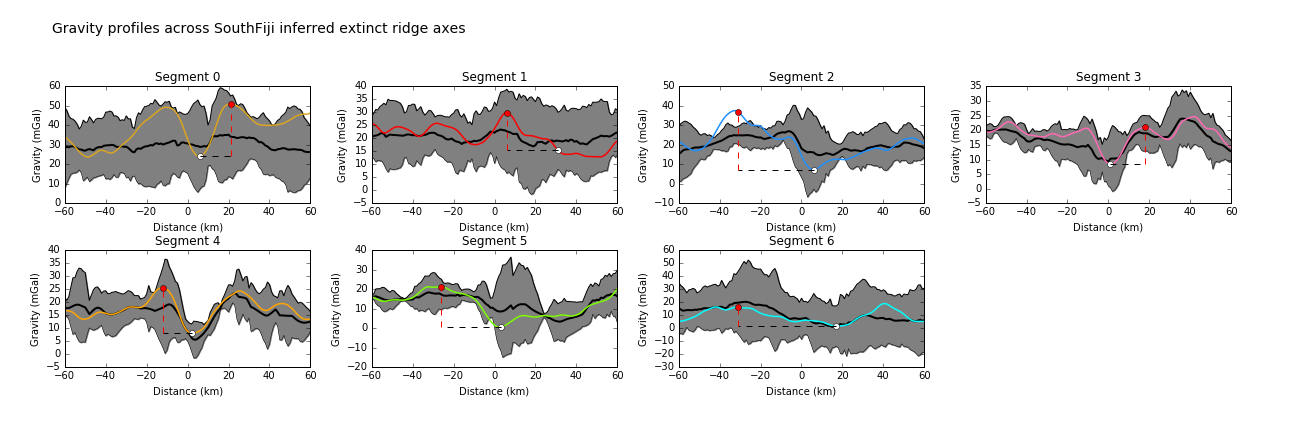| Ocean: | Marginal basin, southwest Pacific |
| Spreading center type: | Back-arc basin spreading center |
| Time of cessation: | Ca. 24 Ma, chron C7 |
| Subsequent active spreading center: | The Lau Basin is a currently active back-arc situated to the immediate east of the South Fiji Basin, that post-dated the South Fiji Basin. |
| Cessation style: | Unclear from literature, insufficient chronological constraints. |
| Later deformation or volcanism: | Possibly hotspot-derived volcanism and possibly faulting (Mortimer et al., 2007) |
The South Fiji Basin is situated in the South West Pacific and was recognized to have had a complex opening in one of the earliest studies of the region, completed by Weissel and Watts (1975). Two sets of magnetic lineations with different spreading orientations were identified by Weissel and Watts (1975), with the anomalies oriented in a north-south direction identified as formed from chron C8 to chron C12 and a more tentatively identified set of east-west trending lineations being more unclear in age.
Sdrolias et al. (2003) provided an updated interpretation of the South Fiji Basin, using existing shiptrack data and aeromagnetic surveys to identify symmetric magnetic anomalies about a three-limbed ridge axis, which they report ceased spreading at Chron 7n. The South Fiji Basin is thought to have formed as a backarc basin spreading center and the spreading axis is moderately well-defined to the north of the basin but less clear within the south of the basin (Sdrolias et al., 2003). Mortimer et al., (1998) proposed that there may have been four microplates active during the formation of the South Fiji Basin, requiring two subduction zone polarity changes, for which there is limited evidence.
In a later study, Mortimer et al. (2007) summarized data from a large number of geochronological and geochemical analyses on samples collected from the South Fiji Basin, Three Kings Ridge and neighbouring ridges and basins. Mortimer et al. (2007) proposed that the South Fiji Basin may have remained active during the early Miocene and possibly up until ca. 19 Ma. Although Sdrolias et al. (2003) interpret the Julia Scarp as an extinct ridge axis, Mortimer et al. (2007) argue that the scarp morphology of the structure is incompatible with an extinct spreading center formation. Unfortunately, however, they do not provide an alternative proposal for the position of the extinct ridge and therefore the identified magnetic anomalies in the basin provided the best constraint on the extinct ridge location.
Subduction-zone trench rollback to the east of the South Fiji Basin was suggested to have led to the abandonment of the backarc spreading system (Sdrolias et al., 2003; Mortimer et al., 2007). Sdrolias et al. (2003) propose this was the second of a series of eastward migrations of both subduction zone and volcanic arc, following an earlier jump from a location west of New Caledonia. A major regional reorganization is proposed at around 25 Ma (Sdrolias et al., 2003, p.357), which is attributed to a change in the direction of the Australian plate motion toward the north-east, that is thought to have reduced trench rollback behind the Tonga-Kermadec trench.
Mortimer, N., Herzer, R. H., Gans, P. B., Parkinson, D. L. and Seward, D., 1998, Basement geology from Three Kings Ridge to West Norfolk Ridge, southwest Pacific Oceam: evidence from petrology, geochemistry and isotopic dating of dredge samples, Marine Geology, v. 148, p. 135-162.
Mortimer, N., Herzer, R. H., Gans, P. B., Laporte-Magoni, C., Calvert, A. T., and Bosch, D., 2007. Oligocene-Miocene tectonic evolution of the South Fiji Basin and Northland Plateau, SW Pacific Ocean: Evidence from petrology and dating of dredged rocks. Marine Geology, v. 237, p. 1–24.
Sdrolias, M., Müller, R.D. and Gaina, C., 2003, Tectonic evolution of the southwest Pacific using constraints from backarc basins, Geological Society of America Special Publication, v. 372, p.343–359.
Weissel, J.K. and Watts, A.B., 1975, Tectonic complexities in the South Fiji marginal basin, Earth and Planetary Science Letters, v. 28, p. 121–126.


